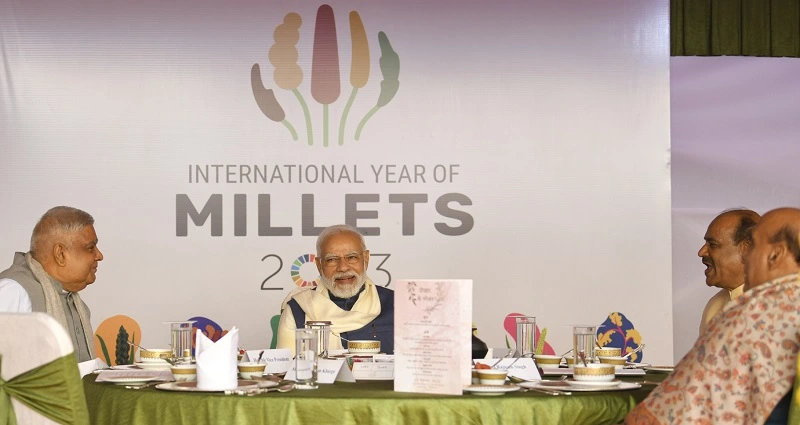

Prime Minister Narendra Modi and other leaders attending a lunch programme in Parliament last December where millet dishes were served to mark 2023 as 'International Year of Millets' (Image courtesy: PIB)
Earlier this month, Bill Gates, Microsoft founder and now co-chairman and trustee of the Gates Foundation India hit the headlines when he prepared a millet khichdi along with Union Minister Smriti Irani.
As the issue of food security takes centre stage on the global map amid rising economic challenges, India’s focus on millets and the production of these grains will allow New Delhi to take a pole position in creating and owning the space around healthy cereals. Along with Yoga, the Narendra Modi government, which is aggressively promoting millets as super foods or “Shree Anna” is positioning itself as the seat of wellness and health.
This year is being marked as the International Year of Millets by India with the aim at promoting the consumption of these coarse cereals to boost global food and economic security.
Modi has already called for a global mass millet to grow and consume millets.
In general, more than 97 per cent of millets production and consumption is by developing nations.
According to Researchgate, India is the largest producer of millets with 37.5 per cent of the total global output followed by Sudan and Nigeria.
India’s production of millets in the overall foodgrain basket is still minuscule.
“We are now working on millets and setting their food standards. Also, to increase consumption of these grains, production of these grains must increase,” G Kamala Vardhana Rao, CEO, Food Safety and Standards Authority of India (FSSAI) told India Narrative.
The food regulator has now set up a comprehensive group standard for 15 types of millets. Until recently, only a few of these cereals such as Ragi, Jowar, Bajra and Amaranth were prescribed in the food standards guideline.
Deepti Dua, a nutritionist and food expert said that inclusion of millets in daily diets has significantly increased in India. “The benefits (of these grains) are immense..each of these millets is packed with nutrition and health benefits which are especially required to fight today’s lifestyle diseases,” Dua said.
More importantly, these grains are now being used to make “fancy” food items such as pastas and noodles, Dua added.
“Eating millets does not necessarily have to be boring, the awareness level is rising and the markets are now flooded with millet noodles, millet pastas or even pohas,’” she said.
Millet crops, which take less time to grow, are drought resistant and can be produced in dryland. These crops not only require 70 per cent less water than rice but consume about 40 per cent less energy as well.
The Department of Agriculture and Farmers Welfare has already taken up a programme to increase production of millets. Pearl millet or bajra, one of the most popular grains is being promoted in 89 districts of nine states which include Gujarat, Himachal Pradesh and Jammu & Kashmir besides several other northeastern states.
Also read: In message to FAO, PM Modi calls for a global mass movement to promote millets
India gears up for International Year of Millets with big push to grain at farms in 2023
Highlighting the use of indigenous platforms during Operation Sindoor, Chief of Defence Staff (CDS) General…
Congress MP Shashi Tharoor on Friday (local time) said that Colombia will issue a statement…
Minister for Electronics and Information Technology Ashwini Vaishnaw said on Friday that the government is…
Renowned human rights activist and political analyst Amjad Ayub Mirza has expressed a strong denunciation…
As was widely expected, the Indian economy grew by 6.5 per cent in real terms…
World No Tobacco Day, marked annually on 31 May, addresses a major public health challenge--the…